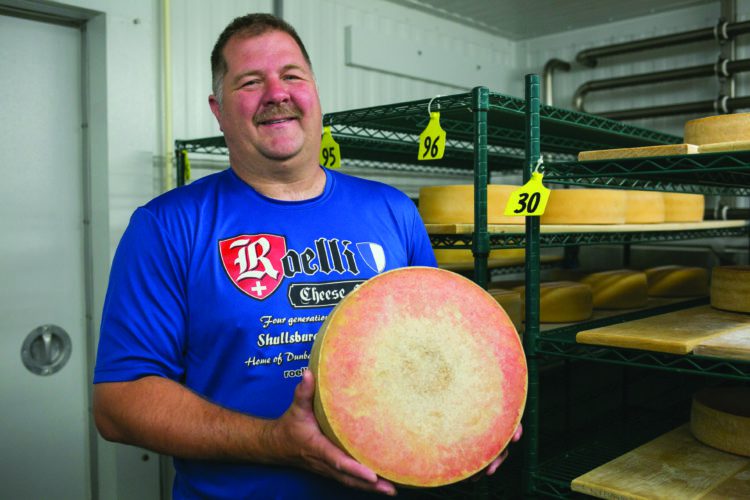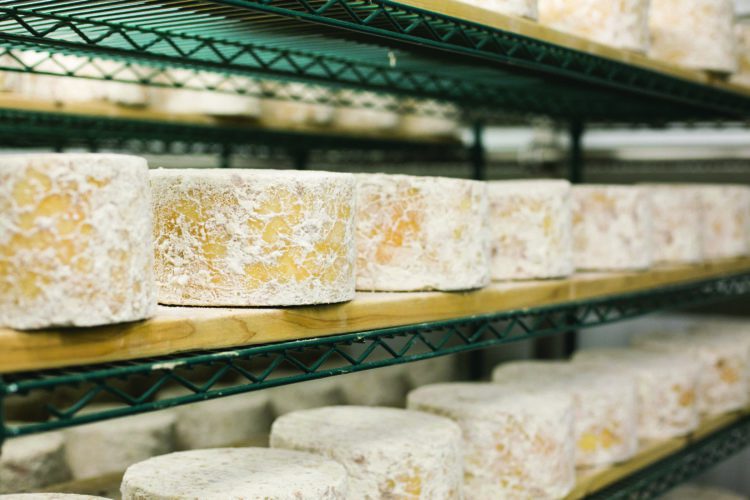
On July 29, 2016, Chris Roelli was not having a good day. The cheesemaker and his wife, Kristine, were driving from Shullsburg, Wis., to Des Moines, Iowa, for the American Cheese Society Conference and Competition—an industry gathering and awards ceremony that seemed like it couldn’t have come at a worse time. “I wasn’t even going to go because we had things going on with our kids,” Kristine remembers. “But we thought, we’ll just slip in and slip out.”
On the way, Chris accidentally drove an hour and a half off track. Arriving late, the duo barely had a moment to check into their hotel room, let alone register for the conference or dress up. They couldn’t even remember what categories they’d entered—and Chris wasn’t feeling hopeful. As awards were declared and the ceremony drew to a close, he was sure he hadn’t won. “I’m going to the bathroom,” he told Kristine.
But then, an announcement: The first-place winner of an aged, washed-rind category was Little Mountain—from Roelli Cheese Haus. Suddenly it dawned on him: he’d qualified for the finals. “He’s like, ‘Oh?!” Kristine recalls. “Well, I’d better stick around.” One by one, champions were announced: Third Place Best in Show, Second Place Best in Show. And then his own wheel graced the screen: Chris Roelli was the maker of First Place Best in Show. Little Mountain had bested 1,842 entries for the title of top cheese in America.
After that, Chris says, everything was a blur. “We ended up on stage. There were a million cameras in front of me.” Whisked toward a TV crew, he was separated from Kristine, who was frantically phoning the family. Later that night, the couple walked to a packed bar; upon entering, they were met with a standing ovation. “We just didn’t know how to act about that,” Chris says. “It was something.” A dream come true, yes—but also overwhelming. “We’re not those people. People that go on the red carpet for attention.”
Deep Roots
Indeed, it’s hard to imagine Chris Roelli on a red carpet. He stands tall and proud, but with an affable humbleness that exudes no vanity; his twinkling eyes constantly hint at a smile without ever spilling into exaggerated enthusiasm. It’s far easier to imagine him solo on an alp, stoically stirring a vat of curds in a copper kettle. Indeed, that’s where he’d likely be today, had his great-grandfather Alfred Rölli not left Switzerland in search of a better life in America.
Chris doesn’t know too much about Alfred, aside from the basics: The youngest of 11 kids, he apprenticed as a cheesemaker in Switzerland and France. He nearly migrated to Russia but was deterred by some disquieting advice from a friend who’d made the trip (“Bring a gun,” the man advised). Instead, Alfred entered the U.S. through Ellis Island and eventually settled in Shullsburg, Wis., in the 1920s. He began working for the Hicks Cheese Factory—a little co-op making Limburger, cheddar, and brick cheese—and eventually became its owner.
Over the years, subsequent generations—including Alfred’s son Walter and grandson Dave—expanded the business to maximize efficiency and volume, churning out commodity cheddar. Chris, who grew up helping Dave (his father) in the factory, earned his Wisconsin Cheesemaker’s license and was poised to join the family trade after graduating from college in 1991.
But one month prior to graduation, Dave made a grave announcement: The factory was shutting down. “The equipment had gotten old, and there was no money in cheddar,” he says. The market was saturated. Prices were low—just pennies per pound. Competition for milk was vicious, and soaring interest rates discouraged new investment. Those obstacles “kind of take the wind out of your sails after a while,” Dave recalls soberly, evoking a time he’d seemingly rather forget. “And you gotta do what you gotta do.”
The Roellis concentrated on their existing milk trucking operation and country store. Although Chris grew up planning to make cheese, without the family business, “I thought that was the end of it,” he says. He experimented with different career paths: trucking, firefighting. While volunteering on an ambulance squad, he met Kristine, a nurse. They married; life went on.
A Lingering Legacy
Looking back on that time, Chris sees a silver lining. “I wonder if things happen for a reason,” he says, grateful now that his father didn’t give him “the chance to take over something that would’ve failed.”
After ten years of soul searching, the born-and-bred cheesemaker hadn’t forgotten his family history. Plus, he’d started noticing something new happening in Wisconsin: a growth in artisan cheese. He toyed with the idea of returning to cheesemaking, just in small quantities. But it wasn’t easy to convince the rest of his family, still rattled from the company’s downturn. His father responded with cautionary advice.
“I said to him: If you’re gonna make cheese, you find something that’s yours to make,” Dave remembers. “You’re not gonna compete for supermarket space, compete with high-volume commodity cheese. Whatever you do, it’s gotta be special.”
Chris’ modest disposition betrays few hints of a fervent creative drive, but a rebellious side emerges—albeit gently—when he speaks about his craft. “I had to think outside the box,” he says. Kristine, who now works alongside the rest of the Roellis running the business, claims that independent thinking “is totally him,” citing their kids’ oft-repeated commentary: “Dad does what he wants.” So Chris started rebuilding the family cheese plant. And in between batches of cheddar and Monterey Jack, he began zooming in on that “something special.”

Roelli’s Dunbarton Blue.
Getting Creative
Inspired by rumors that Neal’s Yard Dairy customers in London paid extra for defective cheddar with blue mold–filled cracks, Chris combined recipes for two of his favorite styles. Like a traditional English cheddar, that experimental wheel—known as Dunbarton Blue—was pressed and cave-aged for several months; like a blue, it was inoculated with Penicillium roqueforti mold spores and pierced before aging. The pressing, which left less room for mold to flourish, resulted in a lovable nutty-sharp combination layered with an approachable hit of blue piquancy.
When Chris gave cheese consultant Kate Arding a taste of that first wheel, she was intrigued. While the moisture content was higher than the traditional English style that inspired Chris, it “really helped to highlight the blue flavors,” she says. “The taste was balanced, delicious, and different.” She immediately brought samples to a dinner with some shop owners in Madison, Wis., and the rest is history.
As orders for Dunbarton poured in, it was clear that thinking outside the box was paying off. While making a batch of orange cheddar one day in 2011, Chris tipped an extra dose of annatto coloring—plus some blue mold spores—into the vat. The experiment yielded Red Rock, a loaf-shaped cousin of Dunbarton with an unforgettably colorful appearance. Fewer piercings and a shorter aging period lend it a milder flavor, still punctuated by an earthy, all-natural rind that develops in the aging cave. To proliferate the hearty molds, Chris built a new affinage cellar in 2012. There, each of his blue cheddars has its own room to age in.
A third aging room is devoted to the newest creation: Little Mountain. It’s something of a double entendre, reflecting Chris’ ventures into new territory and the return to his roots. Knowing he wanted to make a Swiss mountain style but lacking experience in Alpine wheels, the cheesemaker turned to the Wisconsin Center for Dairy Research for help developing a recipe and proprietary blend of cultures.
What resulted is something akin to an Appenzeller, but in a class of its own. Washed repeatedly in a brine-yeast-bacteria solution during at least seven months of aging, it’s floral and delicate, with lingering almond notes.
Forging Forward
The day of Little Mountain’s unexpected win was bittersweet. Only 1,200 total pounds of the cheese existed—almost all of it too young for sale. With the phone ringing off the hook, Chris faced the daunting task of rationing wheels, and nearly buckled under the pressure. “The greatest moment of your life all of a sudden becomes a huge weight,” he says. Rushing the aging process was out of the question. “You can’t get that kind of acclamation, then turn around and sell some junk.”
Instead, the goal has been to build up supply without compromising quality. Chris continues to buy milk from Peter Cernek—who runs a family farm six miles down the road in Gratiot—picking it up several times a week in his little truck. He pays well above industry premium for the raw material, which comes from a grass- and dry hay–fed, mostly Holstein herd. When we peek into Little Mountain’s aging room, it’s packed to the brim with 500 wheels on wooden planks, leaving barely enough room for workers to enter with a Swiss-made wheel-brushing machine. New cheeses fit only when aged ones exit—that’s one reason why there’s “never going to be a lot of it” available, Chris says.
In fact, an entire year after the ACS win, the Roellis have only just caught up with the orders that poured in afterward. Following many phases of growing pains, Chris says, “we’re finally hitting our stride.” The short-term goal is steadier growth; the long-term goal is to one day reap the benefits of tireless work—to travel a bit, maybe even make it back to see family in Switzerland.
Speaking with Chris and his father, I see how far the industry has come. When I ask Dave what he first thought of his son’s inventive cheeses, he admits being a bit miffed. “That goes back historically,” he says. “There’s just some things you didn’t think of doing.” Chris agrees: “When my dad was doing his thing, it wasn’t cool or accepted to go outside the box.” But many of today’s cheesemakers share Chris’ innovative outlook. “We all learned from immigrants,” he says, “but we’re putting our own spin on things.” From neighboring dairies like Uplands Cheese and Hook’s Cheese, to state institutions like the Wisconsin Milk Marketing Board, Chris is thankful for the advice, camaraderie, and support of his peers, without which “we might have lasted two years and then been done,” he says. “But that’s not happened.”
Indeed, after the conference was finished, the Roellis got back in their truck and arrived home in the middle of the night. “I had to get up early the next morning because somebody had to get the milk,” Chris remembers. And so, after a couple hours of sleep, he was far from the red carpet, driving his truck alone through the undulating hills of Wisconsin’s expanse of green farmland, ready to make cheese another day.



